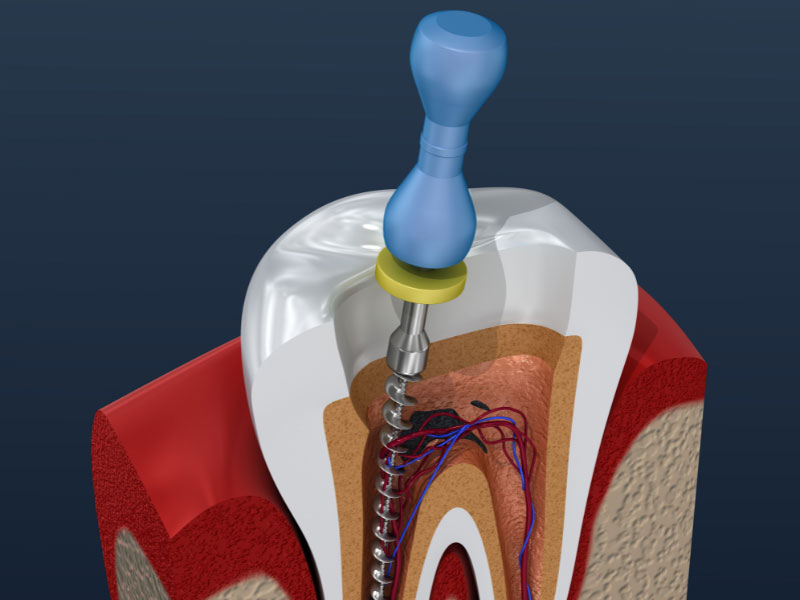A Closer Look at Root Canal Treatment

Your tooth is at extreme risk of needing to be extracted, and you want to know, is there a way to save your tooth?! The short answer is yes, with a root canal! Root canal treatment, also known as endodontic treatment, is designed to eliminate bacteria from the infected root canal, prevent reinfection of the tooth and save the natural tooth. When one undergoes a root canal, the inflamed or infected pulp is removed and the inside of the tooth is carefully cleaned and disinfected, then filled and sealed. (American Association of Endodontists, 2023).
Root canal procedures are actually quite common and are performed in our office, with certain situations that may call for additional visits with a specialist depending on the severity and difficulty of the procedure. If this situation occurs, Dr. Smith will refer you to a specialist referred to as an Endodontist.
When is a Root Canal Procedure Necessary?
When the soft tissue inside the root canal, otherwise known as the pulp, becomes inflamed or infected, a root canal is needed. The reason your pulp may has inflammation or an infection can be for a variety of reasons; deep decay, repeated dental procedures on the tooth or a crack or chip in the tooth. In addition, an injury to a tooth may cause pulp damage even if the tooth has no visible chips or cracks. If pulp inflammation or infection is left untreated, it can cause pain or lead to an abscess. (American Association of Endodontists, 2023). The lesson here is yes, if your dentist says you need root canal treatment, it is in fact necessary. Without receiving root canal treatment, you will end up needing your tooth extracted and will more likely than not have additional troubles with your oral health down the road.
Do I Need a Root Canal…?
If you are reading this blog and asking yourself that question, at the very least, you should be scheduling a check up with your dentist. Your dentist will be able to take a look at your tooth, evaluate the situation, and suggest the appropriate treatment moving forward. Look, we get it. You don’t want to have to make a trip to the dentist if you don’t need one, so you’re looking for a little more that that, right? Well lucky for you, the American Association of Endodontists provides a list of a few symptoms that may mean you need a root canal. Now remember, if you have any of these symptoms, the best option is to schedule an appointment with your dentist.
Symptoms that may suggest the need for a root canal:
- Severe pain while chewing or biting
- Pimples on the gums
- A chipped or cracked tooth
- Lingering sensitivity to hot or cold, even after the sensation has been removed
- Swollen or tender gums
- Deep decay or darkening of the gums
A Step by Step of a Root Canal Procedure
1. To start the procedure off, you will receive a local anesthetic to make sure that you do not experience any pain while the work is being done on your tooth. Your dentist will then take x-rays of the infected tooth to determine how deeply the tooth is damaged and if the infection has gotten into the bone. A dental dam, which is simply a small protective sheet, will then be placed over the area to isolate the tooth and keep it clean and free of saliva during the procedure.
2. The dentist will then proceed to make an opening in the crown of the tooth. The pulp is then cleaned out of the pulp chamber and root canals with small dental instruments. Cleaning the pulp out is what shapes the space for the filling.
3. Once the pulp is cleaned out and the area is shaped, the next step is for the dentist to fill the root canals with a biocompatible material, usually a rubber-like material called gutta-percha. The gutta-percha is placed with an adhesive cement to ensure complete sealing of the root canals. In most cases, a temporary filling is placed to close the opening. The temporary filling will be removed by your dentist before the tooth is restored. (American Association of Endodontists, 2023).
4. The final step is to have a restoration placed on the tooth, most likely a crown, to protect the tooth and all it to be restored to its full functionality.
An additional step may be needed if the tooth is lacking enough structure to hold the restoration in place. If that is the case, your dentist will place a post inside of the tooth for additional support.
You may have heard that a root canal treatment is very painful. However, the procedure is not painful at all and will give you relief from the pain you had been experiencing before you visited us. You may experience some mild discomfort with having to keep your mouth open and having saliva suctioned out of your mouth. Get a look into the exact process Dr. Smith uses should you receive root canal treatment at Spokane Dental!
Root Canal Treatment at Your Spokane Dentist
We know root canal treatments are often considered a procedure that may cause dental anxiety, but at Spokane Dental, we’re committed to making your experience as smooth as possible! If you think you may need root canal treatment, schedule a consultation, or give us a call today!

